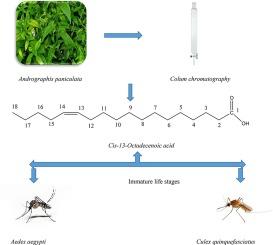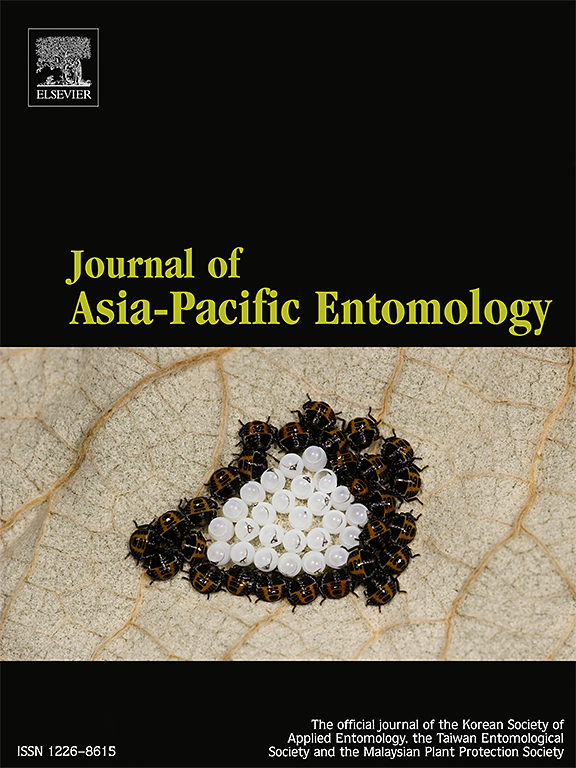Investigation on the mosquitocidal property of cis-13-Octadecenoic acid isolated from Andrographis paniculata against Aedes aegypti and Culex quinquefasciatus (Diptera: Culicidae)
IF 1.3
3区 农林科学
Q3 ENTOMOLOGY
引用次数: 0
Abstract
Mosquitoes are a critical global public health concern, causing millions of deaths each year due to the viral infections and diseases they spread. In recent decades, synthetic insecticides and repellents have been used to control mosquito populations and virus transmission, but they often harm the environment and non-target organisms, including humans. This research investigates the isolation, characterization, and structural elucidation of cis-13-Octadecenoic acid derived from Andrographis paniculata, and its effectiveness against the immature stages of Aedes aegypti and Culex quinquefasciatus. The extracts from A. paniculata underwent fractionation, with the most bioactive fractions being further purified and analyzed. Spectroscopic techniques were employed to confirm the structure of cis-13-Octadecenoic acid. Biological assays were then performed to evaluate its ovicidal, larvicidal, and pupicidal activities. cis-13-Octadecenoic acid exhibited notable ovicidal activity, causing 25 % mortality in Ae. aegypti eggs and 29 % mortality in Cx. quinquefasciatus eggs at a concentration of 2 ppm. Additionally, it showed strong larvicidal and pupicidal activities, with LC50 values of 2.67 ppm and 3.39 ppm for Ae. aegypti larvae and pupae, and 3.10 ppm and 2.93 ppm for Cx. quinquefasciatus larvae and pupae, respectively. These findings demonstrate the potential of cis-13-Octadecenoic acid as an effective natural compound for mosquito control, highlighting the broader importance of natural products as alternatives to synthetic insecticides in the management of vector-borne diseases.

从穿心莲中分离的顺式-13-十八碳烯酸对埃及伊蚊和库蚊(双翅目:蚤科)的杀蚊特性研究
蚊子是一个重要的全球公共卫生问题,每年因其传播的病毒感染和疾病造成数百万人死亡。近几十年来,人们一直使用合成杀虫剂和驱虫剂来控制蚊虫数量和病毒传播,但它们往往会对环境和包括人类在内的非目标生物造成危害。本研究调查了从穿心莲中提取的顺式-13-十八碳烯酸的分离、表征和结构阐释及其对埃及伊蚊和库蚊未成熟阶段的有效性。穿心莲提取物经过分馏,生物活性最强的部分被进一步纯化和分析。利用光谱技术确认了顺式-13-十八碳烯酸的结构。顺式-13-十八碳烯酸具有显著的杀卵活性,在百万分之 2 的浓度下,埃及蚁卵的死亡率为 25%,昆虫卵的死亡率为 29%。此外,它还具有很强的杀幼虫和杀蛹活性,对埃及伊蚊幼虫和蛹的半数致死浓度分别为 2.67 ppm 和 3.39 ppm,对五步蛇幼虫和蛹的半数致死浓度分别为 3.10 ppm 和 2.93 ppm。这些发现表明顺式-13-十八碳烯酸作为一种有效的天然化合物具有控制蚊虫的潜力,突出了天然产品作为合成杀虫剂替代品在病媒传播疾病管理中的广泛重要性。
本文章由计算机程序翻译,如有差异,请以英文原文为准。
求助全文
约1分钟内获得全文
求助全文
来源期刊

Journal of Asia-pacific Entomology
Agricultural and Biological Sciences-Insect Science
CiteScore
2.70
自引率
6.70%
发文量
152
审稿时长
69 days
期刊介绍:
The journal publishes original research papers, review articles and short communications in the basic and applied area concerning insects, mites or other arthropods and nematodes of economic importance in agriculture, forestry, industry, human and animal health, and natural resource and environment management, and is the official journal of the Korean Society of Applied Entomology and the Taiwan Entomological Society.
 求助内容:
求助内容: 应助结果提醒方式:
应助结果提醒方式:


